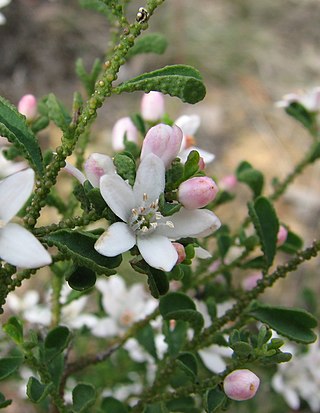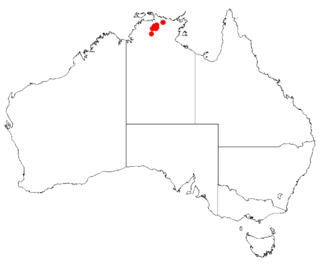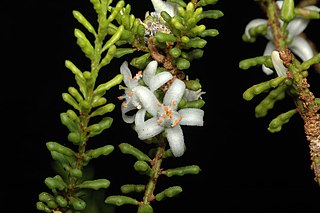
Thryptomene micrantha, commonly known as ribbed thryptomene, is a species of flowering plant in the family Myrtaceae and is endemic to south-eastern Australia. It is a spreading to erect shrub with egg-shaped leaves, the narrower end towards the base, and white flowers with five petals and five stamens.

Philotheca verrucosa, commonly known as fairy wax-flower or Bendigo wax-flower, is a species of flowering plant in the family Rutaceae and is endemic to south-eastern Australia. It is a small shrub with prominently glandular-warty branchlets, heart-shaped or egg-shaped leaves with the narrower end towards the base, and white flowers usually arranged singly in leaf axils.

Philotheca myoporoides, commonly known as long-leaf wax flower, is a species of flowering plant in the family Rutaceae and is endemic to south-eastern Australia. It is a shrub with sessile, oblong to egg-shaped, glandular-warty leaves and white to pink flowers arranged singly in leaf axils. Prior to 1998 it was known as Eriostemon myoporoides.
Philotheca pungens, commonly known as prickly waxflower, is a species of flowering plant in the family Rutaceae and is endemic to south-eastern Australia. It is an undershrub with linear to narrow oblong or needle-like leaves and white flowers usually arranged singly in leaf axils.
Boronia rozefeldsii, commonly known as Schouten Island boronia, is a species of plant in the citrus family Rutaceae and is endemic to a small Tasmanian island. It is an erect, woody shrub with pinnate leaves and pink, four-petalled flowers. It is similar to B. pilosa which grows on the same island, but has larger petals and fewer hairs on the leaflets.

Boronia xanthastrum is a species of small shrub that is endemic to the Northern Territory. It has yellow, star-like hairs on the young branches, leaves and parts of the flowers, elliptical to lance-shaped leaves and small yellowish green flowers.
Philotheca falcata, commonly known as the sickle-leaved waxflower, is a species of flowering plant in the family Rutaceae and is endemic to a small area in the south-west of Western Australia. It is a small, densely branched shrub with narrow club-shaped leaves and single flowers on the ends of branchlets.
Philotheca fitzgeraldii is a species of flowering plant in the family Rutaceae and is endemic to the south of Western Australia. It is an erect, compact or spreading shrub with cylindrical, glandular-warty leaves and white flowers arranged singly in leaf axils and on the ends of branchlets.

Philotheca glasshousiensis is a species of flowering plant in the family Rutaceae and is endemic to Queensland. It is a shrub with densely glandular-warty branchlets, lance-shaped to wedge-shaped leaves clustered near the ends of the branchlets and cream-coloured flowers arranged singly or in groups of up to five.
Philotheca kalbarriensis is a species of flowering plant in the family Rutaceae and is endemic to Western Australia. It is a shrub with reddish brown branchlets and crowded, narrow spindle-shaped leaves and single white flowers arranged in leaf axils.

Philotheca myoporoides subsp. acuta is a subspecies of flowering plant in the family Rutaceae and is endemic to New South Wales. It is a shrub with narrow oblong or narrow elliptic leaves and white flowers arranged singly or in groups of up to three in leaf axils.

Philotheca myoporoides subsp. brevipedunculata is a subspecies of flowering plant in the family Rutaceae and is endemic to New South Wales. It is a shrub with oblong or egg-shaped leaves and white or pink flowers arranged singly or in groups of up to three in leaf axils.
Philotheca myoporoides subsp. euroensis is a subspecies of flowering plant in the family Rutaceae and is endemic to a small area in Victoria, Australia. It is a small shrub with curved, broadly elliptic leaves and white or pink flowers arranged singly or in groups of up to four in leaf axils.
Philotheca myoporoides subsp. petraea is a subspecies of flowering plant in the family Rutaceae and is endemic to a small area in Victoria, Australia. It is an erect shrub with leathery, egg-shaped leaves with the narrower end towards the base, and white flowers arranged singly or in groups of up to four in leaf axils.
Philotheca obovatifolia, commonly known as mountain wax-flower, is a species of flowering plant in the family Rutaceae and is endemic to eastern Australia. It is a small shrub with broadly egg-shaped leaves with the narrower end toward the base and densely crowded near the ends of the glandular-warty branchlets, and cream-coloured flowers tinged with pink and arranged singly or in groups of up to five in leaf axils.

Philotheca pachyphylla is a species of flowering plant in the family Rutaceae and is endemic to Western Australia. It is a small shrub with fleshy, oblong, prominently glandular-warty leaves and white flowers arranged singly in leaf axils.

Philotheca queenslandica is a species of flowering plant in the family Rutaceae and is endemic to south-eastern Queensland. It is a wiry shrub with elliptic to egg-shaped leaves with the narrower end toward the base and densely crowded near the ends of the glandular-warty branchlets, and cream-coloured flowers tinged with pink and arranged singly in leaf axils.

Philotheca sporadica, commonly known as Kogan waxflower, is a species of flowering plant in the family Rutaceae and is endemic to south-eastern Queensland. It is a shrub with small, narrow oval leaves with the narrower end toward the base and white flowers with a pink midrib, usually arranged singly on the ends of branchlets.
Philotheca wonganensis, commonly known as Wongan philotheca, is a species of flowering plant in the family Rutaceae and is endemic to the south-west of Western Australia. It is a shrub with thin, cylindrical leaves and white flowers with a pink central stripe, usually arranged singly in leaf axils.

Epacris barbata, commonly known as bearded heath, is a species of flowering plant in the heath family Ericaceae and is endemic to a restricted area of Tasmania. It is an erect shrub with lance-shaped leaves and white, tube-shaped flowers with hairy sepals.












